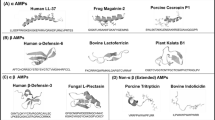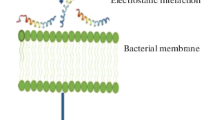Abstract
Endogenous antimicrobial peptides (AMPs) can have multimodal mechanisms of bacterial inactivation, such as membrane lysis, interference with cell wall biosynthesis or membrane-based protein machineries, or translocation through the membrane to intracellular targets. The controlled variation of side-chain characteristics in their amino acid residues can provide much useful information on structure–activity relationships and mode-of-action, and also lead to improved activities. The small size and relatively low complexity of AMPs make them amenable to solid-phase peptide synthesis, facilitating the use of nonproteinogenic amino acids and vastly increasing the accessible molecular diversity of side chains. Here, we describe how such residues can be used to modulate such key parameters as cationicity, hydrophobicity, steric factors conformational stability, and H-bonding.
Access this chapter
Tax calculation will be finalised at checkout
Purchases are for personal use only
Similar content being viewed by others
Abbreviations
- AA:
-
Amino acid
- DBU:
-
1,8-Diazabicyclo[5.4.0]undec-7-ene
- DCM:
-
Dichloromethane
- DIPCDI:
-
Diisopropyl carbodiimide
- DKP:
-
Diketopiperazine
- DMF:
-
N,N-dimethylformamide
- DODT:
-
3,6-Dioxa-1,8-octanedithiol
- EDT:
-
Ethaneditiol
- Fmoc:
-
Fluorenylmethyloxycarbonyl
- HFIP:
-
Hexafluoroisopropanol
- HOBt:
-
Hydroxybenzotriazole
- ivDde:
-
1-(4,4-Dimethyl-2,6-dioxo-cyclohexylidene)-3-methyl-butyl
- Mmt:
-
Monomethoxytrityl
- NMP:
-
N-methylpyrrolidone
- OSu:
-
Succinimidyl carbonate
- PEG-PS:
-
Polyethyleneglycol-polystyrene
- PG:
-
Side-chain protecting group
- PIP:
-
Piperidine
- PyBOP:
-
(Benzotriazol-1-yl-oxy)tripyrrolidinophosphonium hexafluoro phosphate
- s.r.v.:
-
Swelled resin volume
- SPPS:
-
Solid-phase peptide synthesis
- TIPS:
-
Triisopropylsilane
References
Hancock R E, Sahl H G (2006) Antimicrobial and host-defense peptides as new anti-infective therapeutic strategies. Nat Biotechnol 24, 1551–1557.
Brogden K A (2005) Antimicrobial peptides: pore formers or metabolic inhibitors in bacteria? Nat Rev Microbiol 3, 238–250.
Peschel A, Sahl H G (2006) The co-evolution of host cationic antimicrobial peptides and microbial resistance. Nat Rev Microbiol 4, 529–536.
Lai Y, Gallo R L (2009) AMPed up immunity: how antimicrobial peptides have multiple roles in immune defense. Trends Immunol 30, 131–141.
Mattiuzzo M et al. (2007) Role of the Escherichia coli SbmA in the antimicrobial activity of proline-rich peptides. Mol Microbiol 66, 151–163.
Matsuzaki K (2009) Control of cell selectivity of antimicrobial peptides. Biochim Biophys Acta 1788, 1687–1692.
Isidro-Llobet A et al. (2009) Amino acid-protecting groups. Chem Rev 109, 2455–2504.
Zelezetsky I et al. (2005) Controlled alteration of the shape and conformational stability of alpha-helical cell-lytic peptides: effect on mode of action and cell specificity. Biochem J 390, 177–188.
Zelezetsky I et al. (2005) Tuning the biological properties of amphipathic alpha-helical antimicrobial peptides: rational use of minimal amino acid substitutions. Peptides 26, 2368–2376.
Zelezetsky I, Tossi A (2006) Alpha-helical antimicrobial peptides - using a sequence template to guide structure-activity relationship studies. Biochim Biophys Acta 1758, 1436–1449.
Zou G et al. (2007) Toward understanding the cationicity of defensins. Arg and Lys versus their noncoded analogs. J Biol Chem 282, 19653–19665.
Eisenberg D, McLachlan A D (1986) Solvation energy in protein folding and binding. Nature 319, 199–203.
Kyte J, Doolittle R F (1982) A simple method for displaying the hydropathic character of a protein. J Mol Biol 157, 105–132.
Fauchere J L, Pliska V (1983) Hydrophobic parameters pi of amino-acid side chains from the partitioning of N-acetyl-amino-acid amides. J Eur J Med Chem 18, 369–375.
Giangaspero A et al. (2001) Amphipathic alpha helical antimicrobial peptides. Eur J Biochem 268, 5589–5600.
Rothemund S et al. (1995) Structure effects of double D-amino acid replacements: a nuclear magnetic resonance and circular dichroism study using amphipathic model helices. Biochemistry 34, 12954–12962.
Braunstein A et al. (2004) In vitro activity and potency of an intravenously injected antimicrobial peptide and its DL amino acid analog in mice infected with bacteria. Antimicrob Agents Chemother 48, 3127–3129.
Tomasinsig L et al. (2008) The human cathelicidin LL-37 modulates the activities of the P2X7 receptor in a structure-dependent manner. J Biol Chem 283, 30471–30481.
Vunnam S et al. (1998) Synthesis and study of normal, enantio, retro, and retroenantio isomers of cecropin A-melittin hybrids, their end group effects and selective enzyme inactivation. J Pept Res 51, 38–44.
Podda E et al. (2006) Dual mode of action of Bac7, a proline-rich antibacterial peptide. Biochim Biophys Acta 1760, 1732–1740.
Fernandez-Reyes M et al. (2010) Lysine N(epsilon)-trimethylation, a tool for improving the selectivity of antimicrobial peptides. J Med Chem 53, 5587–5596.
Chan D I et al. (2006) Tryptophan- and arginine-rich antimicrobial peptides: structures and mechanisms of action. Biochim Biophys Acta 1758, 1184–1202.
Li S et al. (2010) Water-protein interactions of an arginine-rich membrane peptide in lipid bilayers investigated by solid-state nuclear magnetic resonance spectroscopy. J Phys Chem B 114, 4063–4069.
Tang M et al. (2008) Effects of guanidinium-phosphate hydrogen bonding on the membrane-bound structure and activity of an arginine-rich membrane peptide from solid-state NMR spectroscopy. Angew Chem Int Ed Engl 47, 3202–3205.
Knappe D et al. (2010) Easy strategy to protect antimicrobial peptides from fast degradation in serum. Antimicrob Agents Chemother 54, 4003–4005.
Izdebski J et al. (2007) Synthesis and biological activity of homoarginine-containing opioid peptides. J Pept Sci 13, 27–30.
Gobbo M et al. (2009) Substitution of the arginine/leucine residues in apidaecin Ib with peptoid residues: effect on antimicrobial activity, cellular uptake, and proteolytic degradation. J Med Chem 52, 5197–5206.
Chongsiriwatana N P et al. (2008) Peptoids that mimic the structure, function, and mechanism of helical antimicrobial peptides. Proc Natl Acad Sci USA 105, 2794–2799.
Liu S P et al. (2010) Multivalent antimicrobial peptides as therapeutics: design Principles and structural diversities. Int J Pept Res Ther 16, 199–213.
Pini A et al. (2008) Branched peptides as therapeutics. Curr Protein Pept Sci 9, 468–477.
Tomasinsig L et al. (2006) Mechanistic and functional studies of the interaction of a proline-rich antimicrobial peptide with mammalian cells. J Biol Chem 281, 383–391.
Getahun Z et al. (2003) Using nitrile-derivatized amino acids as infrared probes of local environment. J Am Chem Soc 125, 405–411.
Morgera F et al. (2008) Structuring and interactions of human beta-defensins 2 and 3 with model membranes. J Pept Sci 14, 518–523.
Acknowledgment
This work was supported by the Friuli Venezia Giulia LR 26 regional grant R3A2.
Author information
Authors and Affiliations
Corresponding author
Editor information
Editors and Affiliations
Rights and permissions
Copyright information
© 2012 Springer Science+Business Media, LLC
About this protocol
Cite this protocol
Tossi, A., Scocchi, M., Zahariev, S., Gennaro, R. (2012). Use of Unnatural Amino Acids to Probe Structure–Activity Relationships and Mode-of-Action of Antimicrobial Peptides. In: Pollegioni, L., Servi, S. (eds) Unnatural Amino Acids. Methods in Molecular Biology, vol 794. Humana Press. https://doi.org/10.1007/978-1-61779-331-8_10
Download citation
DOI: https://doi.org/10.1007/978-1-61779-331-8_10
Published:
Publisher Name: Humana Press
Print ISBN: 978-1-61779-330-1
Online ISBN: 978-1-61779-331-8
eBook Packages: Springer Protocols




